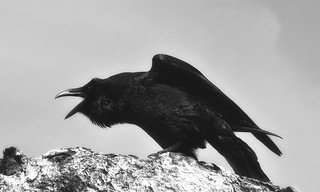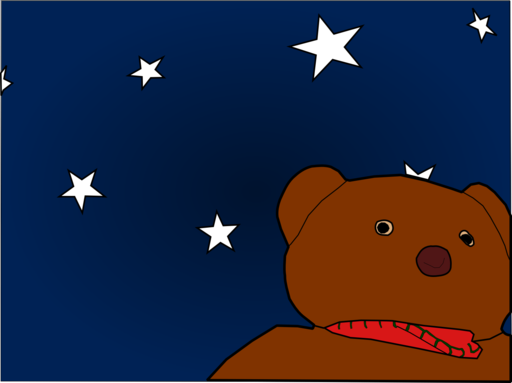In this part of the lesson, you will learn to analyze the graphic elements of a poem such as line length, punctuation, and word position. Poets use these elements to craft their work and convey meaning.
Line length and punctuation
Reading a poem at least twice is essential to appreciating and understanding it. On your first reading, you might highlight every other sentence (not line) in the poem. The first two stanzas of “Twinkle, Twinkle, Little Star” have been highlighted in this manner as an example for you. You can see that the first two stanzas are made up of three distinct sentences.

Source: Alpha Capricorni, Friendlystar, Wikimedia
Twinkle, twinkle, little star,
How I wonder what you are!
Up above the world so high,
Like a diamond in the sky.
When the blazing sun is gone,
When he nothing shines upon,
Then you show your little light,
Twinkle, twinkle, all the night.
Now, it’s your turn to continue in the same manner as the example above. Read the next three stanzas of “Twinkle, Twinkle, Little Star” and click on every other sentence to highlight it.

Look at the poem again and note the sentences highlighted for you and the ones you highlighted. Count them.
Question: How many sentences are there altogether?
Answer: You should have counted a total of six sentences in “Twinkle,Twinkle, Little Star.” Reading a poem sentence-by-sentence is essential to unlocking its meaning.
Although poets write sentences, they divide those sentences into lines of varying lengths to draw the reader’s attention to certain ideas. They also use punctuation, guiding the reader to pause at particular places in the poem. Sometimes the poet encourages the reader to pause at the end of a line by placing a punctuation mark at the end of the line. For example, you are expected to pause at the end of each of the first two lines of “Twinkle, Twinkle, Little Star” as indicated by a comma in the first line and an exclamation point in the second.
Twinkle, twinkle, little star,
How I wonder what you are!
Lines such as those above are called end-stopped lines.
Pay attention to end-stopped lines as well as punctuated pauses within a line by reading the stanza below out loud. Deliberately pause at each highlighted punctuation mark.

Source: Overhead clouds, brandoncripps, Flickr
I wandered lonely as a cloud
That floats on high o’er vales and hills,
When all at once I saw a crowd,
A host, of golden daffodils;
Beside the lake, beneath the trees,
Fluttering and dancing in the breeze.
Notice that Wordsworth intends for you to pause at the end of every line except the first one. He uses commas and a semicolon to guide you. Notice also that he wants you to pause within the fourth and fifth lines as indicated by the commas.
Now, try reading the first stanza of "The Raven" aloud, pausing again midline or at the end of lines as indicated by punctuation marks.

Source: Raven in Winter, Douglas Brown, Flickr
Once upon a midnight dreary, while I pondered, weak and weary,
Over many a quaint and curious volume of forgotten lore –
While I nodded, nearly napping, suddenly there came a tapping,
As of someone gently rapping, rapping at my chamber door –
“‘Tis some visitor,” I muttered, “tapping at my chamber door –
Only this, and nothing more.”
Notice that this six-line stanza consists of only one sentence, but Poe intends for the reader to pause at the end of each line (as indicated by commas, dashes, and period). He also expects the reader to pause after the words “dreary,” “pondered,” “nodded,” “napping,” “rapping,” “visitor,” “muttered,” and “this.” Such midline pauses are called caesurae (si-ZHOO R-ee).
Sometimes the poet does not want you to pause at the end of a line, so punctuation is omitted. This technique is called enjambment or run-on lines. Wordsworth uses enjambment in the example below. He wants you to continue reading without pausing at the end of the first line.
I wandered lonely as a cloud
That floats on high o’er vales and hills,
Let’s see if you can recognize the variety of ways poets guide readers within and between lines. Analyze the examples below and identify whether they contain end-stopped lines, enjambed lines, caesurae, or combinations of the three.

Word position
Word order is also important within lines of poetry. Poets sometimes reverse the usual subject-verb-object order of words in English sentences in order to create inversion. Read the second stanza of “Twinkle, Twinkle, Little Star” aloud, paying special attention to the highlighted line, which is inverted.

Source: Ourson hyp, me, Wikimedia
When the blazing sun is gone,
When he nothing shines upon
Then you show your little light
Twinkle, twinkle, all the night.
The order of the prepositional phrase is reversed. The object of the prepositional phrase nothing comes before the preposition upon. The usual order is illustrated below.
Usual order: When he shines upon nothing
Inverted order: When he nothing shines upon
Read the stanza aloud again and think about why the author chose to use inversion. Notice that the inversion of the words in the line maintains the author’s rhyme scheme of A, A, B, B.
Identify the inverted lines in the examples below by clicking on them to highlight them.

In this part of the lesson, you have seen that in addition to rhyme and meter, poets use graphic elements such as line length, punctuation, and word position to craft their work and convey meaning. You have seen the importance of reading a poem twice and paying attention to those elements whether you are reading a nursery rhyme such as “Twinkle, Twinkle, Little Star” or classic poetry such as “The Raven.”